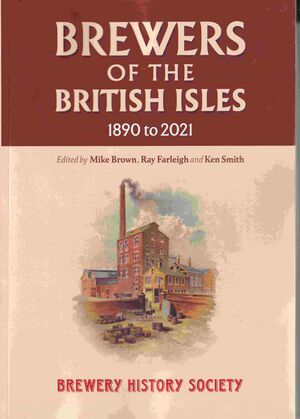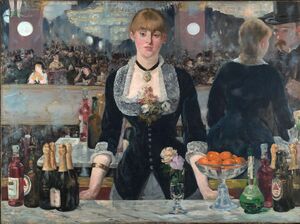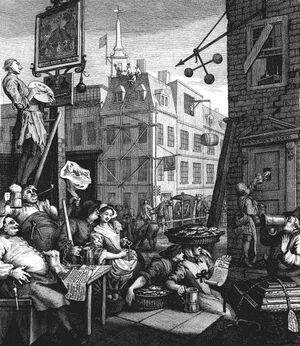Main Page: Difference between revisions
mNo edit summary |
No edit summary |
||
| Line 1: | Line 1: | ||
<big>'''[[File:BoB Front Cover a.jpg|thumb|300px|[https://www.amazon.co.uk/dp/1873966180/ref=cm_sw_em_r_mt_dp_WQF787H0844KZGCDDZAR Click here to order via Amazon]]]'''</big> | |||
[[image:Intro Page aa.jpg|thumb|left]] | |||
[[File:Edouard_Manet 1882,_A_Bar_at_the_Folies-Bergère.jpg|thumb|left|Edouard Manet, 1882, A bar at the Folies Bergère. Note the bottles of Bass.]] | |||
[[Image:Beer Street.jpg|thumb|Hogarth's famous Beer Street]] | |||
[[Image:Home Page 1.jpg|thumb]] | |||
<FONT FACE="HorndonD" SIZE="+3" font color="ff0000"> WELCOME TO Brewerypedia</FONT> | |||
Brewerypedia is '''the''' database of the Brewery History Society. | |||
There are {{NUMBEROFPAGES}} pages of text and photographs in this wiki all relating to breweries both large and small, old and modern. | |||
At present this covers the UK, but as our records expand, we will include Overseas breweries at a later stage. | |||
'''<big>How to access the data</big>''' | |||
The data is driven by company name but thanks to the power of the MediaWiki engine on which this is built, searches are permissible on town and county. Additionally, by using multiple words, companies can be more accurately monitored, eg: Neame Faversham or Steward Norfolk. | |||
Follow this link to access the data by Counties/Areas. The County names used are based on historical boundaries, although London is determined by that of 1948. | |||
* <big>'''[[:Category:British Breweries by County|Breweries by County Index]]'''</big> | |||
* <big>'''[[:Category:Ancillary Brewery Trades|Ancillary Brewery Trades]]'''</big> | |||
* <big>'''[[:Category:Overseas Breweries|Overseas Breweries]]'''</big> | |||
* <big>'''[[:Category:Stately Home Brew Houses|Stately Homes with Brew Houses]]'''</big> | |||
The term brewery includes commercial or common brewers, selling to the trade and individual customers, and brew-pubs (also known as home brew pubs: hbp). The latter would be selling to individual consumers and also includes those premises which brewed for off-sales. | |||
The company histories include details of trading names and dates, addresses including local offices and maltings etc, brand details, labels, trade-marks. | |||
Where available these are illustrated with examples from the Brewery History Society photographic archive. | |||
Where known, the company's tied estate is given. However, as this was always a moving target as it is dependant upon when that manifest was taken. If there are any details of the individual pubs, we will add details and/or photographs of it. | |||
The database includes embedded links to other sites containing historical information eg Cornell. | |||
It is possible to search by individual names, brands and locations. However, the names of individual pub landlords are not usually shown and you would need to consult trade directories and local newspapers when held by county records offices or local studies libraries. | |||
{| class="wikitable" | |||
|<big>'''CAN YOU HELP?'''</big> | |||
|- | |||
|Click below to see a selection of photographs that the Society has that have no location or company name. Maybe you recognise one or two? | |||
Please get in touch if you are able to put a name to an image | |||
|- | |||
|'''[[Mystery Breweries for identification]]''' | |||
|} | |||
<gallery> | |||
File:Cards.jpg | |||
File:Burton cooper.jpg | |||
File:Cooperage Morewhelham Quay Devon.jpg | |||
File:Morewhelham Quay cooperage intertior.jpg | |||
File:Trade Mark Entry (34).jpg | |||
File:Brewers Society generic advert 1.jpg | |||
</gallery> | |||
Latest revision as of 23:36, 12 April 2023
WELCOME TO Brewerypedia
Brewerypedia is the database of the Brewery History Society. There are 52,334 pages of text and photographs in this wiki all relating to breweries both large and small, old and modern.
At present this covers the UK, but as our records expand, we will include Overseas breweries at a later stage.
How to access the data
The data is driven by company name but thanks to the power of the MediaWiki engine on which this is built, searches are permissible on town and county. Additionally, by using multiple words, companies can be more accurately monitored, eg: Neame Faversham or Steward Norfolk.
Follow this link to access the data by Counties/Areas. The County names used are based on historical boundaries, although London is determined by that of 1948.
The term brewery includes commercial or common brewers, selling to the trade and individual customers, and brew-pubs (also known as home brew pubs: hbp). The latter would be selling to individual consumers and also includes those premises which brewed for off-sales.
The company histories include details of trading names and dates, addresses including local offices and maltings etc, brand details, labels, trade-marks.
Where available these are illustrated with examples from the Brewery History Society photographic archive.
Where known, the company's tied estate is given. However, as this was always a moving target as it is dependant upon when that manifest was taken. If there are any details of the individual pubs, we will add details and/or photographs of it.
The database includes embedded links to other sites containing historical information eg Cornell.
It is possible to search by individual names, brands and locations. However, the names of individual pub landlords are not usually shown and you would need to consult trade directories and local newspapers when held by county records offices or local studies libraries.
| CAN YOU HELP? |
| Click below to see a selection of photographs that the Society has that have no location or company name. Maybe you recognise one or two?
Please get in touch if you are able to put a name to an image |
| Mystery Breweries for identification |










